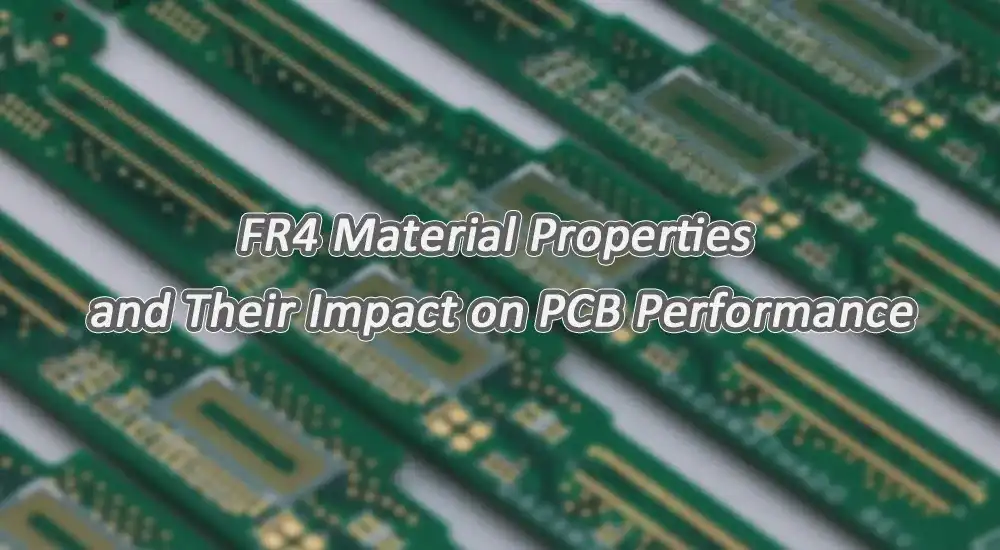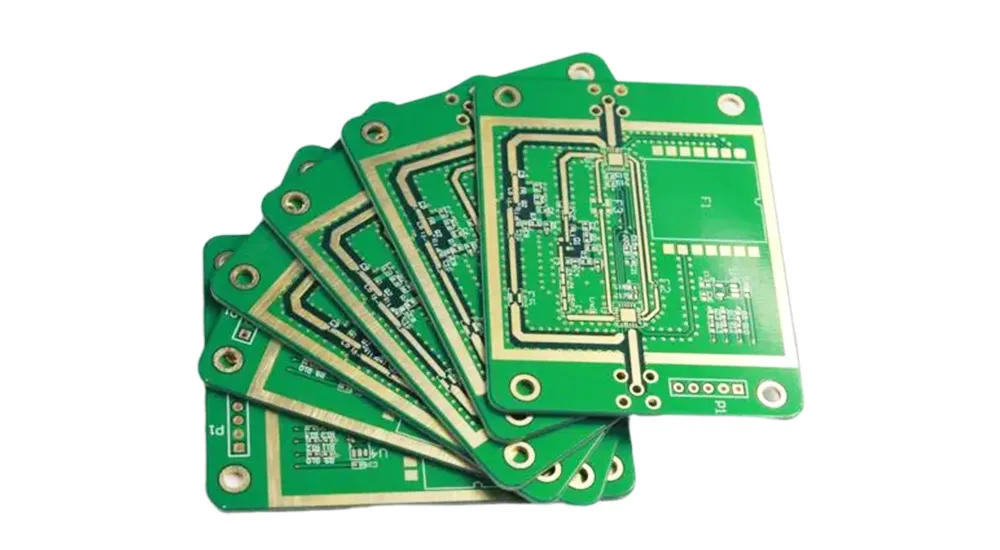
Fundamental FR4 Material Characteristics
FR4 substrate consists of woven fiberglass cloth impregnated with flame-retardant epoxy resin, creating a composite material that balances electrical insulation properties with mechanical durability. The material designation “FR4” indicates flame retardant grade 4, signifying compliance with UL94-V0 flammability standards essential for electronic applications.
The glass weave structure provides dimensional stability and mechanical strength, while the epoxy resin matrix delivers electrical insulation properties. Different glass weave styles, ranging from 1080 to 2116, influence both the electrical characteristics and manufacturing considerations for multilayer PCB stack-ups.
Essential Material Properties and Performance Parameters
| Category | Parameter | Typical Range | Standard Test Method |
|---|---|---|---|
| Electrical Properties | Dielectric Constant (Dk) @ 1MHz | 4.2 - 4.8 | IPC-TM-650 2.5.5 |
| Dissipation Factor (Df) @ 1MHz | 0.018 - 0.025 | IPC-TM-650 2.5.5 | |
| Volume Resistivity | 10¹³ - 10¹⁵ Ω·cm | IPC-TM-650 2.5.17 | |
| Surface Resistivity | 10¹³ - 10¹⁵ Ω | IPC-TM-650 2.5.17 | |
| Dielectric Strength | 800 - 1800 V/mil | ASTM D149 | |
| Thermal Properties | Glass Transition Temperature (Tg) | 130°C - 180°C | DSC Method |
| Decomposition Temperature (Td) | 310°C - 340°C | TGA Method | |
| Coefficient of Thermal Expansion (CTE) | 14-17 ppm/°C (X,Y axis) | IPC-TM-650 2.4.41 | |
| Thermal Conductivity | 0.3 - 0.4 W/m·K | ASTM C177 | |
| Operating Temperature Range | -55°C to +125°C | Application dependent | |
| Mechanical Properties | Flexural Strength | 380 - 450 MPa | ASTM D790 |
| Tensile Strength | 310 - 380 MPa | ASTM D638 | |
| Moisture Absorption | 0.10 - 0.15% | IPC-TM-650 2.6.2 | |
| Density | 1.85 - 1.90 g/cm³ | ASTM D792 | |
| Peel Strength (1 oz copper) | 1.0 - 1.4 N/mm | IPC-TM-650 2.4.8 |
Performance Impact Analysis
Electrical Performance Implications
The dielectric constant directly governs impedance control accuracy in high-speed designs. Standard FR4 exhibits Dk variations of approximately ±10%, translating to impedance variations of ±5%. This variation becomes critical at frequencies above 1 GHz where frequency-dependent dielectric behavior significantly impacts impedance consistency.
The dissipation factor determines insertion loss characteristics for high-frequency signals. Standard FR4 materials exhibit Df values of 0.018-0.025 at 1 MHz, resulting in insertion loss of approximately 0.15-0.20 dB per inch at 1 GHz. This loss increases proportionally with frequency, limiting FR4 suitability for applications exceeding 3-4 GHz.
Thermal Performance Considerations
Glass transition temperature establishes the upper operational limit for reliable performance. Above Tg, the epoxy resin transitions to a rubbery state, causing significant CTE increases and electrical property degradation. The thermal expansion mismatch between FR4 and copper creates mechanical stress during temperature cycling, potentially causing fatigue failures at via interfaces.
Thermal conductivity of 0.3-0.4 W/m·K limits heat dissipation in power-dense applications, necessitating careful thermal management through thermal vias and copper planes.
Mechanical Performance Factors
Flexural strength and anisotropic glass reinforcement influence PCB reliability under mechanical stress. Moisture absorption affects both electrical and mechanical properties, reducing dielectric strength and potentially causing delamination during high-temperature processing. Adequate peel strength prevents conductor lift-off during assembly and ensures thermal cycling reliability.

FR4 Material Selection Guidelines
Application-Specific Considerations
Standard grade FR4 materials provide cost-effective solutions for general-purpose applications operating below 500 MHz with moderate thermal requirements. High-performance FR4 variants such as Isola FR408HR or Nelco N4000-13 offer improved electrical characteristics suitable for applications up to 10 GHz with lower dissipation factors and tighter dielectric tolerances.
Critical parameter matching involves correlating application requirements with material specifications. High-speed digital applications require stable dielectric properties and low loss characteristics. Power electronics prioritize thermal performance and mechanical reliability, while RF applications demand precise dielectric control and minimal loss tangent values.
Environmental and Processing Factors
Lead-free soldering compatibility requires FR4 materials with Tg values above 140°C and decomposition temperatures exceeding 300°C to withstand peak assembly temperatures of 260°C. Applications exposed to high humidity environments benefit from materials with low moisture absorption and enhanced hydrolytic stability.
Manufacturing process compatibility ensures successful fabrication. Via drilling characteristics vary with glass content and resin hardness, while plating adhesion depends on surface preparation and material composition.

Quality Assurance and Testing Standards
Material Certification Requirements
IPC-4101 specification establishes classification systems for FR4 materials based on electrical, thermal, and mechanical performance criteria. This standard enables consistent material selection across suppliers while maintaining manufacturing process compatibility.
Incoming material inspection verifies critical performance parameters through dielectric constant measurement using split-post dielectric resonator techniques and thermal analysis via differential scanning calorimetry to confirm glass transition temperature specifications.
Performance Validation Methods
Electrical characterization employs impedance measurement using time-domain reflectometry to validate calculated values against actual performance. Signal integrity analysis through eye diagram measurement quantifies material property impact on high-speed transmission quality.
Reliability testing protocols establish long-term performance expectations through highly accelerated life testing under elevated temperature and humidity conditions. Thermal shock testing evaluates material response to rapid temperature transitions representative of operational conditions.
Why Choose Haoyue Electronics for Your FR4 PCB Projects
Haoyue Electronics combines advanced FR4 material expertise with comprehensive PCB manufacturing and assembly capabilities to deliver superior electronic solutions. Our engineering team provides material selection guidance tailored to specific application requirements, ensuring optimal performance while maintaining cost-effectiveness.
Our capabilities include:
- Advanced material characterization laboratory with impedance analysis and thermal property testing equipment
- Comprehensive FR4 supplier network providing access to standard and high-performance grade materials
- Precision impedance control manufacturing with ±5% tolerance capability for high-speed applications
- Lead-free assembly processes optimized for high-Tg FR4 materials up to 260°C peak temperatures
- Statistical process control implementation ensuring consistent material properties across production runs
- Technical support for material selection, stack-up optimization, and thermal management solutions
Partner with Haoyue Electronics to leverage our FR4 material expertise and manufacturing excellence for your next PCB project. Contact our engineering team today to discuss your specific requirements and discover how our comprehensive capabilities can enhance your product performance and reliability.

